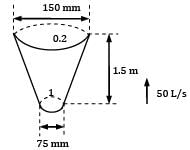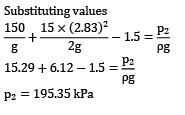Civil Engineering (CE) Exam > Civil Engineering (CE) Questions > A vertical water pipe, 1.5 m long, diverges ...
Start Learning for Free
A vertical water pipe, 1.5 m long, diverges from 75 mm diameter at the bottom to 150 mm diameter at the top and the rate of flow is 50 L/s upwards. If the pressure at the bottom end is 150 kN/m2 , the pressure at the top will be nearly
(!) 195.2 kN⁄m2
- a)191.4 kN⁄m2
- b)187.6 kN⁄m2
- c)183.8 kN⁄m2
Correct answer is option 'A'. Can you explain this answer?
| FREE This question is part of | Download PDF Attempt this Test |
Verified Answer
A vertical water pipe, 1.5 m long, diverges from 75 mm diameter at th...

p1 = 150 × 103
Q = 50 L/s
Applying continuity equation at 1 and 2
V1 x A1 = V2 x A2
V1/V2 = (150/75)2
V1=4 V2
Applying Bernoulli equation and 1 and 2

V2 = 2.83m/sec

Most Upvoted Answer
A vertical water pipe, 1.5 m long, diverges from 75 mm diameter at th...
Solution:
Given data:
Length of the pipe, L = 1.5 m
Diameter of the pipe at the bottom, D1 = 75 mm
Diameter of the pipe at the top, D2 = 150 mm
Rate of flow, Q = 50 L/s
Pressure at the bottom end, P1 = 150 kN/m2
To find: Pressure at the top end, P2
Assumptions:
The flow is steady, incompressible, and inviscid.
The density of the fluid is constant throughout the flow.
The pipe is straight and uniform.
The frictional losses are negligible.
Calculation:
1. Cross-sectional areas at the bottom and top of the pipe:
Area at the bottom, A1 = π/4 (D1)2 = π/4 (0.075)2 = 4.418 × 10-3 m2
Area at the top, A2 = π/4 (D2)2 = π/4 (0.150)2 = 1.767 × 10-2 m2
2. Velocity at the bottom of the pipe:
Velocity at the bottom, V1 = Q/A1 = (50 × 10-3)/4.418 × 10-3 = 11.32 m/s
3. Velocity at the top of the pipe:
Using the principle of continuity, the velocity of the fluid at the top can be calculated as:
A1V1 = A2V2
V2 = A1V1/A2 = (4.418 × 10-3 × 11.32)/(1.767 × 10-2) = 2.828 m/s
4. Pressure at the top of the pipe:
Using Bernoulli's equation between the bottom and top of the pipe, neglecting the frictional losses:
P1/ρg + ½ V1²/g = P2/ρg + ½ V2²/g
where ρ is the density of water and g is the acceleration due to gravity.
Substituting the given values, we get:
150 × 103/ (1000 × 9.81) + ½ (11.32)²/9.81 = P2/ (1000 × 9.81) + ½ (2.828)²/9.81
P2 = 195.2 kN/m2
Therefore, the pressure at the top end of the pipe is 195.2 kN/m2.
Hence, option A is the correct answer.
Given data:
Length of the pipe, L = 1.5 m
Diameter of the pipe at the bottom, D1 = 75 mm
Diameter of the pipe at the top, D2 = 150 mm
Rate of flow, Q = 50 L/s
Pressure at the bottom end, P1 = 150 kN/m2
To find: Pressure at the top end, P2
Assumptions:
The flow is steady, incompressible, and inviscid.
The density of the fluid is constant throughout the flow.
The pipe is straight and uniform.
The frictional losses are negligible.
Calculation:
1. Cross-sectional areas at the bottom and top of the pipe:
Area at the bottom, A1 = π/4 (D1)2 = π/4 (0.075)2 = 4.418 × 10-3 m2
Area at the top, A2 = π/4 (D2)2 = π/4 (0.150)2 = 1.767 × 10-2 m2
2. Velocity at the bottom of the pipe:
Velocity at the bottom, V1 = Q/A1 = (50 × 10-3)/4.418 × 10-3 = 11.32 m/s
3. Velocity at the top of the pipe:
Using the principle of continuity, the velocity of the fluid at the top can be calculated as:
A1V1 = A2V2
V2 = A1V1/A2 = (4.418 × 10-3 × 11.32)/(1.767 × 10-2) = 2.828 m/s
4. Pressure at the top of the pipe:
Using Bernoulli's equation between the bottom and top of the pipe, neglecting the frictional losses:
P1/ρg + ½ V1²/g = P2/ρg + ½ V2²/g
where ρ is the density of water and g is the acceleration due to gravity.
Substituting the given values, we get:
150 × 103/ (1000 × 9.81) + ½ (11.32)²/9.81 = P2/ (1000 × 9.81) + ½ (2.828)²/9.81
P2 = 195.2 kN/m2
Therefore, the pressure at the top end of the pipe is 195.2 kN/m2.
Hence, option A is the correct answer.
Attention Civil Engineering (CE) Students!
To make sure you are not studying endlessly, EduRev has designed Civil Engineering (CE) study material, with Structured Courses, Videos, & Test Series. Plus get personalized analysis, doubt solving and improvement plans to achieve a great score in Civil Engineering (CE).

|
Explore Courses for Civil Engineering (CE) exam
|

|
Similar Civil Engineering (CE) Doubts
A vertical water pipe, 1.5 m long, diverges from 75 mm diameter at the bottom to 150 mm diameter at the top and the rate of flow is 50 L/s upwards. If the pressure at the bottom end is 150 kN/m2 , the pressure at the top will be nearly(!) 195.2 kN⁄m2a) 191.4 kN⁄m2b) 187.6 kN⁄m2c) 183.8 kN⁄m2Correct answer is option 'A'. Can you explain this answer?
Question Description
A vertical water pipe, 1.5 m long, diverges from 75 mm diameter at the bottom to 150 mm diameter at the top and the rate of flow is 50 L/s upwards. If the pressure at the bottom end is 150 kN/m2 , the pressure at the top will be nearly(!) 195.2 kN⁄m2a) 191.4 kN⁄m2b) 187.6 kN⁄m2c) 183.8 kN⁄m2Correct answer is option 'A'. Can you explain this answer? for Civil Engineering (CE) 2024 is part of Civil Engineering (CE) preparation. The Question and answers have been prepared according to the Civil Engineering (CE) exam syllabus. Information about A vertical water pipe, 1.5 m long, diverges from 75 mm diameter at the bottom to 150 mm diameter at the top and the rate of flow is 50 L/s upwards. If the pressure at the bottom end is 150 kN/m2 , the pressure at the top will be nearly(!) 195.2 kN⁄m2a) 191.4 kN⁄m2b) 187.6 kN⁄m2c) 183.8 kN⁄m2Correct answer is option 'A'. Can you explain this answer? covers all topics & solutions for Civil Engineering (CE) 2024 Exam. Find important definitions, questions, meanings, examples, exercises and tests below for A vertical water pipe, 1.5 m long, diverges from 75 mm diameter at the bottom to 150 mm diameter at the top and the rate of flow is 50 L/s upwards. If the pressure at the bottom end is 150 kN/m2 , the pressure at the top will be nearly(!) 195.2 kN⁄m2a) 191.4 kN⁄m2b) 187.6 kN⁄m2c) 183.8 kN⁄m2Correct answer is option 'A'. Can you explain this answer?.
A vertical water pipe, 1.5 m long, diverges from 75 mm diameter at the bottom to 150 mm diameter at the top and the rate of flow is 50 L/s upwards. If the pressure at the bottom end is 150 kN/m2 , the pressure at the top will be nearly(!) 195.2 kN⁄m2a) 191.4 kN⁄m2b) 187.6 kN⁄m2c) 183.8 kN⁄m2Correct answer is option 'A'. Can you explain this answer? for Civil Engineering (CE) 2024 is part of Civil Engineering (CE) preparation. The Question and answers have been prepared according to the Civil Engineering (CE) exam syllabus. Information about A vertical water pipe, 1.5 m long, diverges from 75 mm diameter at the bottom to 150 mm diameter at the top and the rate of flow is 50 L/s upwards. If the pressure at the bottom end is 150 kN/m2 , the pressure at the top will be nearly(!) 195.2 kN⁄m2a) 191.4 kN⁄m2b) 187.6 kN⁄m2c) 183.8 kN⁄m2Correct answer is option 'A'. Can you explain this answer? covers all topics & solutions for Civil Engineering (CE) 2024 Exam. Find important definitions, questions, meanings, examples, exercises and tests below for A vertical water pipe, 1.5 m long, diverges from 75 mm diameter at the bottom to 150 mm diameter at the top and the rate of flow is 50 L/s upwards. If the pressure at the bottom end is 150 kN/m2 , the pressure at the top will be nearly(!) 195.2 kN⁄m2a) 191.4 kN⁄m2b) 187.6 kN⁄m2c) 183.8 kN⁄m2Correct answer is option 'A'. Can you explain this answer?.
Solutions for A vertical water pipe, 1.5 m long, diverges from 75 mm diameter at the bottom to 150 mm diameter at the top and the rate of flow is 50 L/s upwards. If the pressure at the bottom end is 150 kN/m2 , the pressure at the top will be nearly(!) 195.2 kN⁄m2a) 191.4 kN⁄m2b) 187.6 kN⁄m2c) 183.8 kN⁄m2Correct answer is option 'A'. Can you explain this answer? in English & in Hindi are available as part of our courses for Civil Engineering (CE).
Download more important topics, notes, lectures and mock test series for Civil Engineering (CE) Exam by signing up for free.
Here you can find the meaning of A vertical water pipe, 1.5 m long, diverges from 75 mm diameter at the bottom to 150 mm diameter at the top and the rate of flow is 50 L/s upwards. If the pressure at the bottom end is 150 kN/m2 , the pressure at the top will be nearly(!) 195.2 kN⁄m2a) 191.4 kN⁄m2b) 187.6 kN⁄m2c) 183.8 kN⁄m2Correct answer is option 'A'. Can you explain this answer? defined & explained in the simplest way possible. Besides giving the explanation of
A vertical water pipe, 1.5 m long, diverges from 75 mm diameter at the bottom to 150 mm diameter at the top and the rate of flow is 50 L/s upwards. If the pressure at the bottom end is 150 kN/m2 , the pressure at the top will be nearly(!) 195.2 kN⁄m2a) 191.4 kN⁄m2b) 187.6 kN⁄m2c) 183.8 kN⁄m2Correct answer is option 'A'. Can you explain this answer?, a detailed solution for A vertical water pipe, 1.5 m long, diverges from 75 mm diameter at the bottom to 150 mm diameter at the top and the rate of flow is 50 L/s upwards. If the pressure at the bottom end is 150 kN/m2 , the pressure at the top will be nearly(!) 195.2 kN⁄m2a) 191.4 kN⁄m2b) 187.6 kN⁄m2c) 183.8 kN⁄m2Correct answer is option 'A'. Can you explain this answer? has been provided alongside types of A vertical water pipe, 1.5 m long, diverges from 75 mm diameter at the bottom to 150 mm diameter at the top and the rate of flow is 50 L/s upwards. If the pressure at the bottom end is 150 kN/m2 , the pressure at the top will be nearly(!) 195.2 kN⁄m2a) 191.4 kN⁄m2b) 187.6 kN⁄m2c) 183.8 kN⁄m2Correct answer is option 'A'. Can you explain this answer? theory, EduRev gives you an
ample number of questions to practice A vertical water pipe, 1.5 m long, diverges from 75 mm diameter at the bottom to 150 mm diameter at the top and the rate of flow is 50 L/s upwards. If the pressure at the bottom end is 150 kN/m2 , the pressure at the top will be nearly(!) 195.2 kN⁄m2a) 191.4 kN⁄m2b) 187.6 kN⁄m2c) 183.8 kN⁄m2Correct answer is option 'A'. Can you explain this answer? tests, examples and also practice Civil Engineering (CE) tests.

|
Explore Courses for Civil Engineering (CE) exam
|

|
Suggested Free Tests
Signup for Free!
Signup to see your scores go up within 7 days! Learn & Practice with 1000+ FREE Notes, Videos & Tests.
























